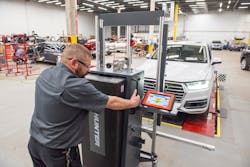You should be doing ADAS calibrations. True or false?
So much has been written about ADAS the past few years that it’s like a lunch buffet: Shop owners may graze along, taking what they want and leaving the rest. And why not? With such a wide array of information, there’s something to suit every palate.
With ADAS so constantly in the air, standing back to gain a little perspective from time to time is a good idea. In this article, we’d like to discuss a number of common beliefs many collision shop owners hold about ADAS, and hopefully offer some helpful insight into where things stand and where they’re headed.
But here’s the spoiler: We think collision shops should give very strong consideration to doing ADAS work. In time, the market and your competitors may even make the choice for you.
I know ADAS is growing, but it hasn’t really “arrived” yet. T or F
False. For billions of reasons.
More than 70 million vehicles on the road today have at least one ADAS component. In the not-so-distant future, all will. As drivers place increasing reliance on ADAS functions, OEMs will continue to develop increasingly refined and sophisticated systems.
But ADAS is a going, and growing, concern right now. In 2021, the ADAS market was calculated to be $27 billion. One recent estimate places it at $75 billion by 2030. For those waiting to see if ADAS is going to be a “real thing,” this is what real things look like.
It’s particularly real for collision shops. Since many routine procedures trigger a calibration, such as installing a new windshield or replacing a bumper, you can imagine what an actual accident does to ADAS components. Almost by definition, nearly every vehicle that makes it to a collision shop will require recalibrations.
This will be a never-ending source of work. And it’s happening now.
ADAS is super-complicated. T or F
Overall true, but that’s not a disqualifier for doing calibrations.
Left alone, the amount of information you’d need to seek out and master would be immense. But you wouldn’t be left alone. That’s what quality equipment and a partner to back it all up is for.
Solid tools will lead your techs through the entire process without undue difficulty (see below). It’s true that ADAS may be intimidating at first, but much of what repair shops deal with today was complicated at first. ADAS may not be an oil change, but if your techs can follow directions, calibrations will be just another routine procedure.
You don’t have to know everything. You just have to know what you’re doing. Your equipment and your support will have a lot to do with that.
ADAS requires super-skilled techs. T or F
False, which is the good news. Unfortunately, the bad news is that it requires something possibly even more difficult to find: careful, patient, diligent techs.
ADAS systems are very complex, although actual calibrations are not. They’re usually straightforward. The challenge comes in methodically following step-by-step instructions and applying attention to detail. Techs willing to move the targets seven times if needed and ensure every single box is checked will be your best ADAS guys.
The reason for this diligence is because ADAS is entirely about safety. Everything has got to be right.
Really right, because close enough is not close enough. Radar or a camera that’s just a fraction of a degree off may seem a nitpicking detail, but it’s not. Think of it as a flashlight beam, with the miscalibration expanding along with the cone of light. What may be insignificant near the bulb becomes dangerous 200 yards out, as the system misidentifies hazards or attempts to correct problems that don’t exist.
To be sure, every shop should capture as many high-skilled, experienced techs as it can. ADAS, however, is about conscientiousness, not special expertise.
ADAS work would be a big investment. T or F
True; it can be. False in that it doesn’t have to be – at least not until you want it to.
Just as you wouldn’t buy a grand piano before you learned to play, you wouldn’t buy elaborate ADAS tools and equipment before learning calibrations. Like anything else, you’d start small and gradually work your way into the market niche appropriate for your business.
You’d do this by doing calibrations for makes and models you’re familiar with. As your shop becomes more experienced and confident, you expand your focus to the next level. The amount of work you’re able to do, and its profitability, will dictate the type of equipment you’ll need to prosper.
There’s no need to jump into the deep water overnight with all makes, all models, all the time. Educate yourself and your techs, gain some experience, and go from there. We believe the ROI will justify your efforts.
It’s too hard to figure ROI on this stuff. T or F
False. It shouldn’t be any more challenging than any other ROI.
According to a recent study by CCC Intelligent Solutions, the average ADAS calibration is $238. The maximum fee was $3,748. Those are for single calibrations. Many vehicles following a collision will need multiple components calibrated, and the higher-end the vehicle, the more sophisticated the calibrations.
Like alignments, ADAS work is high-labor. That $238 is more than twice the typical alignment, and alignments are about the highest margin work you can do. You’ll have a very good idea of the amount of business you can bank on – which will be substantial -- now and in the future.
As noted, once you start the work, the work will dictate where you go with it. If you fully commit to ADAS, you should be fully rewarded.
ADAS is a litigation disaster waiting to happen. T or F
True! Isn’t everything? But seriously: false. ADAS work carries no greater risk than anything else a shop does.
A little wariness is understandable. ADAS may seem to present more immediate bad outcomes than typical procedures. There’s always the chance that a poorly performed or skipped calibration could contribute to a serious accident, and all the more so as drivers get accustomed to vehicles doing everything for them.
Yet that describes a lot of things shops do every day. What happens if you forget to put the brake light bulbs in, and your customer gets rear-ended?
The way to handle risk is not by avoiding a windfall of work. The answer is to make sure you do it right. Shops that do good work will do good ADAS work. Shops not known for doing good work invite risk whether they do ADAS work or not.
Again, this is where quality equipment and a partner you can trust comes in.
I need a lot more space than I have for ADAS work. T or F
False. The majority of calibrations can be done in a space much smaller than you may think.
True, in an ideal world, you’d have an empty warehouse set aside for performing every possible calibration on every possible vehicle. In this world, most vehicles will not require every ADAS function adjusted at the same time, so simultaneous front, side and rear views are rarely necessary.
It’s a case of thinking not outside the box, but inside it. Shops are discovering creative workarounds that allow them to make the most of their space. Most forward-facing calibrations can be completed within 16.5 feet of the front of the vehicle, and many within 10 feet or less. Side and rear views require space primarily in the area of the sensor. In general, if you have approximately 25 x 34 to work with – a bit larger than a typical bay – you should be in good shape.
Should your ROI determine that you could use a 4,500- square-foot facility to do nothing but ADAS, that’ll be the happy time to consider other options. In the meantime, almost everything in the shop is on wheels. If you’re committed to ADAS work, chances are good you can devise a workable configuration.
I can’t do ADAS because I don’t have an alignment rack. T or F
False, although it’s true life would be a lot easier with one, since ADAS work is so intertwined with alignments. But if you’re intent on learning the business, a full rack isn’t necessary.
Mobile sensors and plates mean a dedicated alignment spot for instrumentation isn’t required. You can still measure and adjust vehicles in different places around your shop.
In time, when your ADAS business supports it, you can move up to a full alignment system. (It’s our view that you should do alignment in-house anyway, but that’s another story.)
ADAS is a mess. It’s easier to just sublet it all out. T or F
True. It is easier, in a limited sense. But the path of least resistance isn’t always the best path.
Subletting brings its own headaches: transport risk, additional customer wait, towing reimbursement, quality control, etc. The biggest one, of course, is that someone else gets the money.
The critical problem is that subletting delivers the worst of both worlds. You can’t sublet responsibility. Regardless of who performs the actual work, your name is on the repair -- while someone else’s name is on the check. There’s no offsetting profit for assuming the risk discussed above.
That’s a high price to pay for the “convenience” of not having to mess with ADAS.
I get the ADAS thing. But I can still wait a few years before making a move. T or F
True. Although the longer you wait, the further behind you’ll be when you do enter the business.
As noted, ADAS isn’t complicated on a day-to-day basis, you don’t need a host of super-skilled techs, and you need not go whole-hog right off the bat. Nonetheless, this is a business segment that’s taking off, with unanimous industry consensus that it’s only going to get bigger and bigger.
Plus this: It’s basically tailor-made for collision shops.
Think of all the changes that will likely occur between now and the next three to five years. By then, it’s hard to say just what the ADAS marketplace might look like. Regardless, whatever the scenario, you can bet your shop will be at a disadvantage for having waited.
Will ADAS for collision shops be smooth sailing from day one? Probably not. Will there be growing pains? Sure. It’s a rare new business endeavor that doesn’t bring them. But with patience and diligence and a commitment to education, the real growth you’re looking for – in profitability – will surely be within reach as you enjoy your reputation as the local reliable “ADAS place.”
About the Author

Ryan Gerber
Ryan Gerber is a product specialist/ADAS for Hunter Engineering in Bridgeton, Mo., starting his career with Hunter in 2011 as a business consultant. Gerber has worked in the automotive field more than 30 years, with roles ranging from technician to secondary automotive instructor. He earned a General Motors ASEP Certification and an A.S. in Automotive Technology from Sinclair University.
